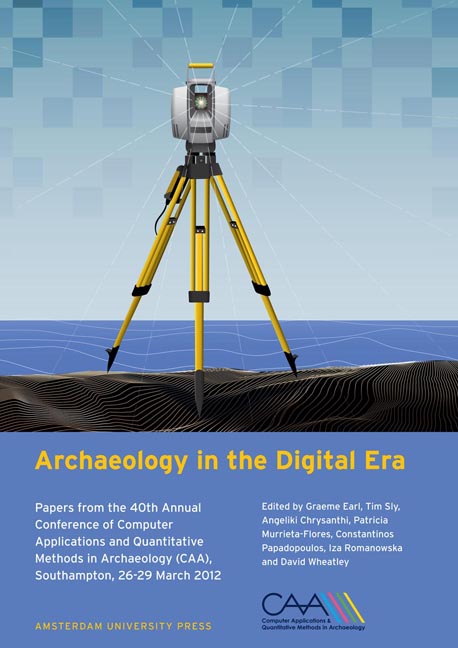 Archaeology in the Digital Era
Archaeology in the Digital Era Steppingin - Modern Humans Moving into Europe - Implementation
Published online by Cambridge University Press: 16 February 2021
Summary
Abstract:
This research focuses on the possible routes taken by the earliest Modern Humans moving into Europe. Suggested routes include the Danube Corridor, the Gibraltar Passage, and the Sicilian Crossing. The aim of this research is to develop a simulation tool able to compare alternative scenarios. The simulator, conveniently called Steppingln, represents groups of modern humans as autonomous agents. Simulations are run with varying model and individual parameters. Archaeological Checkpoints in Space and Time (CSTs) with known location and chronology serve to assess simulation results. Chosen routes are plotted on a map showing emerging colonization patterns through time. Such density plots can serve as a rudimentary predictive model on the likelihood of certain preferences. The simulator is implemented in the REcursive Porous Agent Simulation Toolkit (Repast Simphony 2.0), selected both for its geographical capabilities and the ease of Java integration. Output is presented in Google Earth for further analysis.
Keywords:
Modelling, Simulation, Modern Humans, Paleolithic Europe
Introduction
Modern humans, not only archaeologists, are intrigued by questions about our origins. One of those questions is simply put: “how did modern humans colonize Europe around 40.000 years ago?”. It is one of those key fundamental questions in paleoanthropology and paleolithic archaeology (Roe 2009,5). It seems a question that is easily answered but upon closer inspection one that generates a myriad of other questions about the influence of paleoclimates, possible routes into Europe, seafaring capabilities, Neanderthals, extinction of multiple large animal species, the need for and use of language, the flexibility and effectiveness of toolsets, and about the working of the human mind. Unfortunately, archaeological data is so far insufficient to answer all aspects of that literal “how” question. It is unknown when modern humans first touched European soil (however you define Europe) and which route was taken afterwards…
The aim of this research is to deliver a simulation tool able to compare alternative scenarios for moving into Europe. The simulator, conveniently called Steppingln, can calculate with several model parameters and show their effects on the geographical movement of our species. Simulation techniques have previously been used to analyse important events, like SteppingOut with Homo erectus leaving Africa (Mithen and Reed (2002) but also Nikitas and Nikita (2005)), the arrival of modern humans into the Americas (Steele et al.
- Type
- Chapter
- Information
- Archaeology in the Digital EraPapers from the 40th Annual Conference of Computer Applications and Quantitative Methods in Archaeology (CAA), Southampton, 26-29 March 2012, pp. 105 - 117Publisher: Amsterdam University PressPrint publication year: 2014


